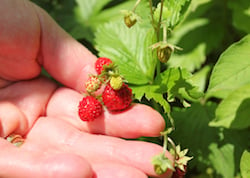Hope Is Something You Do With Your Feet
By Josh Noem ’98, ’05 MDiv
I have this memory of my grandmother shooting a deer that had wandered through her farm during hunting season. She field-dressed it, and I remember seeing its carcass hanging from a tree in the yard.
I honestly can’t tell if I’m just imagining this from my early childhood, so I consulted my older cousins to see if they recall the scene. Results are mixed, but we all agree on one thing: she was certainly capable of such a feat.


Raised during the Depression, she maximized everything the earth produced. She kept bees for honey and chickens for eggs (and drumsticks). I remember stalking wild asparagus with her in ditches and windbreaks. At her funeral, we laughed to remember her vigilant berry-picking—she couldn’t drag herself away from a strawberry patch for fear of missing one and letting it go to waste.
Of the many stories I will tell my children and grandchildren about her, one stands above even the (real or imagined) deer-slaying.
After my grandfather died when they were in their early 60s, she stayed faithful to what she had always known, and went about maintaining the farm and staying active in the church despite a gaping hole in her life. And when she was tempted to feel depressed or lonely, or that God had abandoned her on the open plains of eastern South Dakota, she would bake a pan of bars and mix up a pitcher of lemonade and go out to visit someone else who might be feeling the same way. She made visits across that far-flung prairie, sweets in hand, to buoy friends and family and to keep her own head above water.

These were small acts of hope baked in the creaky oven in her cramped farmhouse kitchen, and though they were hidden and obscure, they brought new life to others.
She was Lutheran, but I don’t think Grandma would mind that I now see Mary’s light reflected in her. Both trusted in the fruit born by quiet faithfulness; both were tirelessly devoted to work; both had strength to bear great sorrow.
Both women were able to intuit gaping need—within themselves and in others—and stepped out to build a bridge. After being visited by an angel, Mary hastened to the hill-country of Judea to visit her cousin, Elizabeth. Grandma trusted the hidden solidarity of loneliness to knock on a door with a plate of cookies.
We see beauty in the faces of these women who have given themselves over to the “self-offering totality of love.” They refused to settle for self-pity, and they made faithfulness into something you do with your feet. And when they stepped out beyond themselves, they found that God was being faithful, too.
In the light of Mary, the Church sees in the face of women the reflection of a beauty which mirrors the loftiest sentiments of which the human heart is capable: the self-offering totality of love; the strength that is capable of bearing the greatest sorrows; limitless fidelity and tireless devotion to work; the ability to combine penetrating intuition with words of support and encouragement. (Redemptoris Mater, #46)

